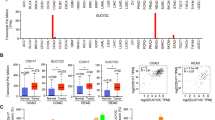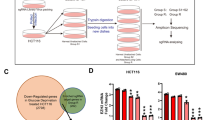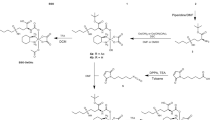Abstract
ZD2767P, a nitrogen mustard glutamate prodrug, is currently being evaluated in Phase 1 clinical trials of antibody directed enzyme prodrug therapy (ADEPT). There was no significant relationship between basal glutathione (GSH) concentration and sensitivity to ZD2767P + carboxpeptidase G2 (CPG2) in colorectal tumour cell-lines. Depletion of intracellular GSH using buthionine sulfoximine (BSO) resulted in only a modest potentiation of ZD2767P + CPG2 activity and hence BSO is unlikely to markedly enhance the activity of this ADEPT treatment. © 2000 Cancer Research Campaign
Similar content being viewed by others
Article PDF
Change history
16 November 2011
This paper was modified 12 months after initial publication to switch to Creative Commons licence terms, as noted at publication
References
Alaoui-Jamali MA, Panasci L, Centurioni GM, Schecter R, Lehnert S and Batist G (1992) Nitrogen mustard-DNA interaction in melphalan-resistant mammary carcinoma cells with elevated intracellular glutathione and glutathione- S -transferase activity. Cancer Chemother Pharmacol 30: 341–347
Blakey DC, Burke PJ, Davies DH, Dowell RI, East SJ, Eckersley KP, Fitton JE, McDaid J, Melton RG, Niculescu-Duvaz IA, Pinder PE, Sharma SK, Wright AF and Springer CJ (1996) ZD2767, an improved system for antibody-directed enzyme prodrug therapy that results in tumour regressions in colorectal tumour xenografts. Cancer Res 56: 3287–3292
Chen T (1977) In situ detection of mycoplasma contamination in cell cultures by fluorescent Hoechst 33258 stain. Exp Cell Res 104: 255–262
Cotgreave IA and Moldeus P (1986) Methodologies for the application of monobromobimane to the simultaneous analysis of soluble and protein thiol components of biological systems. J Biochem Biophys Methods 13: 231–249
Friedman HS, Dolan ME, Kaufmann SH, Colvin OM, Griffith OW, Moschel RC, Schold SC, Bigner DD and Ali-Osman F (1994) Elevated DNA polymerase α, DNA polymerase β, and DNA topoisommerase II in a melphalan-resistant rhabdomyosarcoma xenograft that is cross resistant to nitrosoureas and topotecan. Cancer Res 54: 3487–3493
Hall AG and Tilby MJ (1992) Mechanisms of action of, and modes of resistance to, alkylating agents used in the treatment of haematological malignancies. Blood Rev 6: 163–173
Hayes JD and Wolf CR (1990) Molecular mechanisms of drug resistance. Biochem J 272: 281–295
Hogarth LA, Rabello CMA and Hall AG (2000) Measurement of reduced glutathione using high-pressure liquid chromatography. Methods in Molecular Medicine 28: 91–94
Skehan P, Storeng R, Scudiero D, Monks A, McMahon J, Vistica D, Warren JT, Bokesch H, Kenney S and Boyd MR (1990) New colorimetric cytotoxicity assay for anticancer-drug screening. J Natl Cancer Inst 82: 1107–1112
Smith CV, Jones DP, Guenthner TM, Lash LH and Lauterburg BH (1996) Compartmentation of glutathione: implications for the study of toxicity and disease. Toxicol Appl Pharmacol 140: 1–12
Springer CJ, Dowell R, Burke PJ, Hadley E, Davies DH, Blakey DC, Melton RG and Niculescu-Duvaz I (1995) Optimization of alkylating agent prodrugs derived from phenol and aniline mustards: a new clinical candidate prodrug (ZD2767) for antibody-directed enzyme prodrug therapy (ADEPT). J Med Chem 38: 5051–5065
Author information
Authors and Affiliations
Rights and permissions
From twelve months after its original publication, this work is licensed under the Creative Commons Attribution-NonCommercial-Share Alike 3.0 Unported License. To view a copy of this license, visit http://creativecommons.org/licenses/by-nc-sa/3.0/
About this article
Cite this article
Monks, N., Calvete, J., Curtin, N. et al. Cellular glutathione as a determinant of the sensitivity of colorectal tumour cell-lines to ZD2767 antibody-directed enzyme prodrug therapy (ADEPT). Br J Cancer 83, 267–269 (2000). https://doi.org/10.1054/bjoc.2000.1240
Received:
Revised:
Accepted:
Published:
Issue date:
DOI: https://doi.org/10.1054/bjoc.2000.1240



